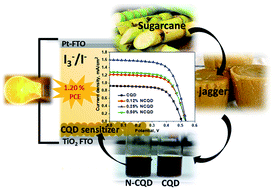Harnessing the N-dopant ratio in carbon quantum dots for enhancing the power conversion efficiency of solar cells†
Abstract
Nowadays, green materials are being prepared to a greater extent to conserve the environment. Due to their outstanding properties, carbon quantum dots (CQDs) are becoming the alternatives of the conventional semiconductor-based quantum dots and organic dyes. We reported the one-step synthesis of CQDs and nitrogen-doped carbon quantum dots (NCQDs) by the solvothermal treatment of green and renewable non-centrifugal cane sugar. The successful syntheses of CQDs and NCQDs were substantiated by various physicochemical techniques such as Fourier-transform infrared spectroscopy (FTIR), Raman spectroscopy, transmission electron microscopy (TEM), and X-ray photoelectron spectroscopy (XPS). The photoluminescence quantum yields of CQDs and NCQDs were observed to be 5.2% and 9.8%, respectively. Due to their commendable photostability, these NCQDs with different loadings of nitrogen were applied as green sensitizers in TiO2-based solar cells. These NCQDs achieved the highest power conversion efficiency of 1.20% under 0.1 sun illumination (AM 1.5). We believe that this competitiveness of the fabrication of CQDs from the cheapest and green source is the most promising and useful for light harvesting.



 Please wait while we load your content...
Please wait while we load your content...